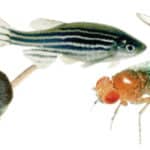
[Disclaimer: I am an employee of Celgene. The views reported here are my own.]
On a recent family vacation to Cumberland Island, a 9,800-acre barrier island off the coast of Georgia, I was mesmerized by the dense forest of live oak trees covered with Spanish moss. Upon first glance, the branches of these magnificent trees extend chaotically in all directions, and it is difficult to discern where the trees begin and end. But upon closer inspection, the root structure can be identified, moss disentangled, and the overall complexity unraveled.
These craggy oak trees serve as metaphor for our complex human biological ecosystem: a dense forest of molecules with gnarled branches of pathways meandering in all directions, without an obvious root structure of human disease. Extending the metaphor further, the oak trees make the point that I see as one of the most difficult aspect of drug discovery and development: understanding root cause of disease, and matching therapeutic modality and biological mechanism to prevent or cure devastating illness.
In this blog, I highlight two recent publications that underscore the importance of matching modality and mechanism. The first article, published in the New England Journal of Medicine, reported clinical data on 22 patients with beta-thalassemia treated with ex vivo gene therapy (here).…
Read full article...

Over the holidays my family participated in an Escape Room, a live puzzle adventure game. We worked as a team to solve riddles, find clues and, over the course of 60-minutes, complete an old town bank heist. Many of the successful clues came from unexpected places – coordinates on maps, numbers inscribed in hidden places, and physical features of the room itself. Other clues seemed promising, but ultimately led to dead ends. In the end, everything came together and we escaped with only seconds to spare.
And so it goes with the invention of new medicines. The approval of a new medicine is an Escape Room of sorts, but over the course of decades not minutes. And like an Escape Room, clues can come from unexpected places, with some leading to new insights and others leading to dead ends.
I was in an Escape Room state-of-mind as I read a Science Translational Medicine article that developed a system to differentiate blood cells into microglia-like cells to study gene variants implicated in neurodegenerative disorders (here). In this blog, I provide a brief summary of the study, and then describe the potentially interesting phenomenon of genetically driven tissue-specific pathogenicity.…
Read full article...

As readers of my blog know, I am a strong supporter of a disciplined R&D model that focuses on: picking targets based on causal human biology (e.g., genetics); developing molecules that therapeutically recapitulate causal human biology; deploying pharmacodynamic biomarkers that also recapitulate causal human biology; and conducting small clinical proof-of-concept studies to quickly test therapeutic hypotheses (see Figure below). As such, I am constantly on the look-out for literature or news reports to support / refute this model. Each week, I cryptically tweet these reports, and occasionally – like this week – I have the time and energy to write-up the reports in a coherent framework.
Of course, this model is not so easy to follow in the real-world as has been pointed out nicely by Derek Lowe and others (see here). A nice blog this week by Keith Robison (Warp Drive Bio) highlights why drug R&D is so hard.
Here are the studies or news reports from this week that support this model.
(1) Picking targets based on causal human biology: I am a proponent of an “allelic series” model for target identification. Here are a couple of published reports that fit with this model.…
Read full article...

I recently listened to a TED Radio Hour podcast on failure (link here). Casey Gerald reminded listeners that while his biographical narrative is impressive (here), there have been many failures along the way.
This got me thinking…why don’t more people write their personal biographies in such a way that highlights their successes and failures? I have not seen one, and LinkedIn certainly does not encourage us to log our failures publicly. (Maybe an entrepreneur should start a site called LinkedOut, where you endorse people for failures and bios must be written with failures included!)
So I thought I would give it a try.
I will start with my conventional “success” bio (which can also be found here) to provide context. Then, I will provide my new “failure” bio (also here). At the end, I provide a brief “lessons learned” on how failures have shaped my professional life. I conclude with a shout out to Charles Darwin, one of history’s most famous observer of failure in nature.
[Disclaimer: I am a Merck/MSD employee. The opinions I am expressing are my own and do not necessarily represent the position of my employer.]
Here is my conventional “successful” professional biography.…
Read full article...

I know it may seem strange that I am commenting on my own commentary. While writing the Science Translational Medicine (STM) article (here, here), I wanted to focus on a clear vision for improving R&D productivity via integrating human biology, therapeutic modulation, pharmacodynamics biomarkers, and proof-of-concept clinical trials (see Figure 1 of the manuscript, also above). Too often, these four key concepts get lost amongst the many steps in drug development. I won’t revisit these concepts here, as I encourage you to read the article itself.
However, there is much more to R&D productivity than just these four concepts, and the purpose of this blog is to broaden the perspective piece a bit.
[Disclaimer: I am a Merck/MSD employee. The opinions I am expressing are my own and do not necessarily represent the position of my employer.]
1. Drug discovery should always start with the patient. Every drug discovery journey must begin with a clear definition of the unmet medical need. As a former practicing rheumatologist, I always try to keep in mind the questions that a patient would ask me: “Why did I develop this disease?” “Will I respond to this medication?” “What is my prognosis?”…
Read full article...

One of the biggest challenges of drug discovery is to determine which targets, when perturbed, will have an acceptable efficacy-safety therapeutic window in patients. In fact, the success rate at choosing the right target and developing a safe and effective drug is quite low: less than 10% of drugs that enter Phase I are approved by regulatory authorities (see recent Nature Reviews Drug Discovery article here, Derek Lowe blog here). Most of the failures in Phase II and III are due to lack of efficacy or unexpected toxicity.
Human genetics offers one potential solution to identify new drug targets with an acceptable therapeutic window. A study published this week in Science Translational Medicine (STM) provides genetics support for an established therapeutic target in type 2 diabetes (T2D), glucagon-like peptide-1 receptor, GLP1R (link to STM article here). What is surprising, however, is that human genetics suggests that GLP1R agonists may also protect from coronary heart disease (CHD).
[Disclaimer: I am a Merck/MSD employee. The opinions I am expressing are my own and do not necessarily represent the position of my employer.]
There are three points that I want to make in this blog. First, the STM study provides general support for the model that human genetics is useful to predict efficacy & safety in drug discovery.…
Read full article...

Inevitably when I post a blog on “human biology” I get a series of comments about the importance of non-human model organisms in drug discovery and development. My position is clear: pick targets based on causal human biology, and then use whatever means necessary to advance a drug discovery program to the clinic.
Very often, non-human model organisms are the “whatever means necessary” to understand mechanism of action. For example, while human genetic studies identified PCSK9 as an important regulator of LDL cholesterol, mouse studies were critical to understand that PCSK9 acts via binding to LDL receptor (LDLR) on the surface of cells (see here). As a consequence, therapeutic antibodies were designed to block circulating PCSK9 from the blood and increase LDLR-mediated removal of circulating LDL (and hopefully to protect from cardiovascular disease).
Moreover, non-human animal models are necessary to understand in vivo pharmacology and safety of therapeutic molecules before advancing into human clinical trials.
Beyond drug discovery, of course, studies from non-human animal models provide fundamental biological insights. Without studies of prokaryotic organisms, for example, we would not have powerful genome-editing tools such as CRISPR-Cas9. Without decades of work on mouse embryonic stem cells, we would not have human induced pluripotent stem cells (iPSCs).…
Read full article...
The primary purpose of this blog is to recruit clinical scientists into our new Translational Medicine department at Merck (job postings at the end). However, I hope that the content goes beyond a marketing trick and provides substance as to why translational medicine is crucial in drug discovery and development. Moreover, I have embedded recent examples of translational medicine in action, so read on!
[Disclaimer: I am a Merck/MSD employee. The opinions I am expressing are my own and do not necessarily represent the position of my employer.]
There is a strong need to recruit clinical scientists into an ecosystem to develop innovative therapies that make a genuine difference in patients. This ecosystem requires those willing to toil away at fundamental biological problems; those committed to converting biological observations into testable therapeutic hypotheses in humans; and those who develop therapies and gain approval from regulatory agencies throughout the world. The first step is largely done in academic settings, and the other two steps largely done in the biopharmaceutical industry…although I am sure there are many who would disagree with this gross generalization!
The term “Translational Medicine” has been broadly used to describe the second step, thereby bridging the Valley of Death between the first and third steps.…
Read full article...

I read with interest a recent publication by Khandpur et al in Science Translational Medicine on NETosis in the pathogenesis of rheumatoid arthritis (download PDF here). It made me think about “cause vs consequence” in scientific discovery. That is, how does one determine whether a biological process observed in patients with active disease is a cause of disease rather than a consequence of disease?
In reading the article, I learned about how neutrophils cause tissue damage and promote autoimmunity through the aberrant formation of neutrophil extracellular traps (NETs). Released via a novel form of cell death called NETosis, NETs consist of a chromatin meshwork decorated with antimicrobial peptides typically present in neutrophil granules. (Read more about NETs on Wikipedia here.)
Mendelian randomization is a method of using measured variation in genes of known function to examine the causal effect of a modifiable exposure on disease in non-experimental studies (read more here). It is a powerful to determine if an observation in patients is causal. For example, if autoantibodies are pathogenic in RA, then DNA variants that influence the formation of autoantibodies should also be associated with risk of RA. This is indeed the case, as exemplified by variants in a gene, PADI4, the codes for an enzyme involved in peptide citrullination (see here). …
Read full article...









